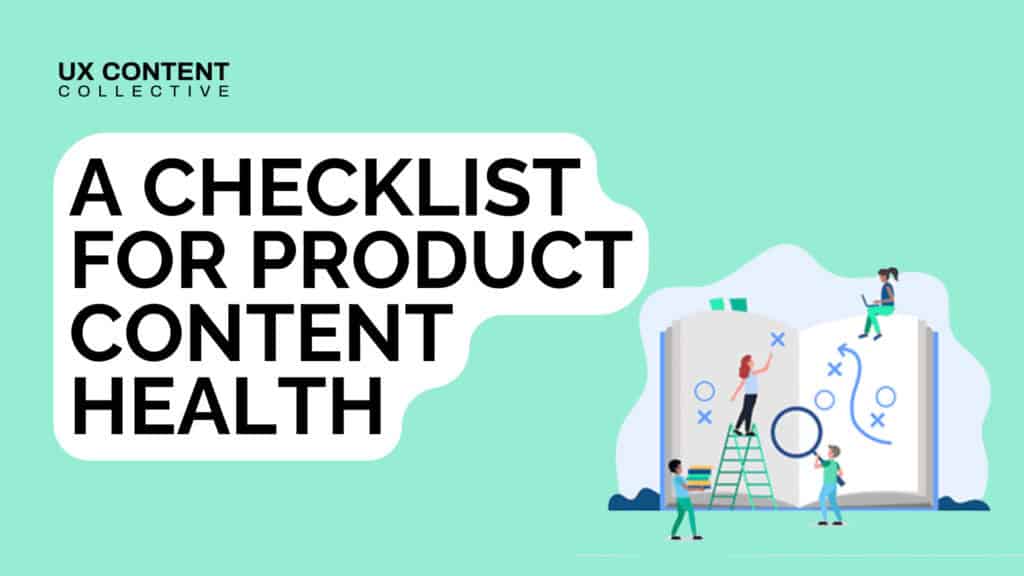

Interested in UX writing and content design?
Explore our content design and UX writing training:

Does working with product content get easier the longer you’re at it?
I’ve found it feels like putting together a jigsaw puzzle. Most of the time, I don’t manage to use all the pieces, no matter how I arrange them.
Before I managed content and digital platforms for startups, service companies, and even an enterprise business, my first boss told me a thing that still stays with me: “If you’re the only person working with content in your organization, of course it’s hard. You’re the only person who gets to see all parts of it.”
But here’s what I learned after working in this field 10+ years.
No matter the type of organization, if your role is to manage content, you’ll see teams that struggle with the same things.
- They’ll find it challenging to define their brand messaging and how to apply it.
- They’ll find it hard to connect their content efforts to their business goals.
- They’ll strive to create better content, and struggle to curate and organize what already exists.
- They’ll have workshops and arguments over who owns, creates and edits content across teams and platforms.
Even if your job description says you own the content in your organization, the truth is the content assets you’re stewarding aren’t standalone things you can do whatever you want with. They’re an ecosystem running throughout your whole organization, and they keep it running.
Scott Kubie framed it as the Death Star of content that’s part of your business. Pull on one thread and it affects the whole system. Change one part and you need to check how it cascades through the whole organization.
So if you need to think of your content as an ecosystem instead of individual assets, how do you get it right? If your decisions affect everyone, how is it supposed to work?
As with all complex answers, it starts with “It depends”. But I can get you started with a content checklist, so you know how to set yourself up for success.
A content checklist for a healthy ecosystem
Content checklist item #1. A healthy content ecosystem provides consistent customer experiences across all touch points
The larger and more complex your digital platforms, the harder it is to get this right. But here’s how you win here.
All teams, whether they’re marketing, product, customer support or other should communicate the same things about your product, features, or services.
To achieve this, work on creating always up-to-date internal knowledge bases. Make sure teams leading a launch or a campaign disseminate information internally, and don’t just focus on making their project an external success.
Run regular content inventories across all platforms and assets.
Content inventories run once or twice a year can identify content that is outdated or incomplete, which you should refresh or retire. Inventories are also an opportunity to check in with other teams to see what assets they regularly use, what their feedback is, and how you can support them.
Play the role of the customer to test out specific interactions.
This is an accessible way to see for yourself what it’s like to interact with your organization as an outsider. Test what it looks like to get support, participate in a sales demo or use a new feature. New team members are perfect for this role, because they’re seeing everything with fresh eyes.
Content checklist item #2. A healthy content ecosystem has common storylines and original thought leadership to represent the brand across all assets
We tend to think of brand positioning as either something complex or fluffy. But at its core, it’s the ability to articulate what value your users are getting from using your product, and why they should choose you instead of anything else available on the market.
When you can do that, it’s easier to build common threads in your brand narrative, no matter where you apply it. And you can apply it in places like:
- Product releases, where you want to narrow down on the impact of a specific set of features
- Case studies, where you talk about the impact you brought to a specific client
- Opinion pieces on market trends and industry best practices, where you talk about why your way of doing things is better in a specific context (bonus points if you can make your case with proprietary data and examples)
- Any external communications where you want to highlight how you bring value to a specific audience category.
Content checklist item #3. A healthy content ecosystem has clear publishing processes in place, using tools like AI where it makes sense
Your publication processes are mapped, and each team member knows what’s their scope and role in the process
You shouldn’t have conflicts over missing bits of content, images someone forgot to resize, screens someone forgot to check, because everyone knows what their job is. This also means teams won’t go off doing their own thing, because they’ll trust a system that works.
Everyone knows who signs off what
This doesn’t mean you need to have one central point that checks everything, but you’ve got a system through which assets get checked before they go live, whether by buddies, team leads of otherwise.
You use tools for specific goals and avoid overlap
Your techstack is straightforward and useful. You’ve got tools for research, for creation, for analytics, and yes, even AI assistance, and you’re using them with a clear purpose in mind.
Content checklist item #4. A healthy content ecosystem has reporting in place to support the organization’s activities and decision making
We can now gather data for pretty much anything. Yet it’s still hard for organizations to measure their progress and make evidence-based decisions. So how do you win here?
- Tie all your activities (marketing campaigns, website changes, product updates) to metrics that measure progress you care about. If you can’t, why are you doing them? Start talking about how work affects the metrics you care about, and you’re moving towards making evidence-based decisions.
- Data is simple, but context is hard. And that’s ok. It will be easier to measure the metrics in front of you, like how many people are converting or how many people are using a feature. It’ll be harder to ask more complex questions like tracking cohorts or doing experiments. Keep asking questions anyway to learn by doing.
Content checklist item #5. A healthy content ecosystem prioritizes quality and curation of the assets being published
The worst thing that can happen to an organization is that they fall into a routine of running a conveyor belt of content publishing. How do you avoid that?
Understand your audience’s customer journey, and tie your editorial plans to it. This can look like having specific topics, resources and demos on your website, to support acquisition. It can mean having a specific structure to your knowledge base, to support learning and engagement. You’ll find that some topics will always be relevant, and you’ll be better off focusing on always having fresh content on those, rather than producing new things on less relevant topics.
Content checklist item #6. A healthy content ecosystem is seen as an asset owned by the entire organization
When you make big decisions on how your content ecosystem works, it affects teams’ workflows and KPIs. So how do you do the hard work of getting alignment here?
Build a sense of ownership for content in the organization
If you had subject matter experts contribute to a content asset, give them credit. If a department uses content as a solution to reach their goals, let them have the win. Your organization’s content ecosystem is a shared resource, so make the team feel a sense of ownership for it.
Make allies in other departments
Build positive relationships with managers from other teams and stakeholders from all over your organization. These are the people you will go to when you want to gain insights and feedback on the quality and impact of your work.
Get a decision maker on your side
Sometimes, you will have the expertise to know how to get a big, cross-department project done, but not the authority to get other teams to commit to it. So focus to get a person with authority on your side, like a C-level manager, or even the CEO. If you get their buy-in, they can help you with aligning the other stakeholders.
Building healthy content ecosystems is a long game
Getting your organization’s content ecosystem right is hard. And while there isn’t a magic recipe that will create a healthy, perfectly running content ecosystem for any organization, what you can do as the person in charge of content is take this checklist and make it work for you.
You’re in the best position to advocate for the value of content done right, to know how to meet your team members where they are, and to understand who your audience is and what matters to them. You’ve got this, good luck!



